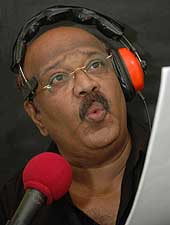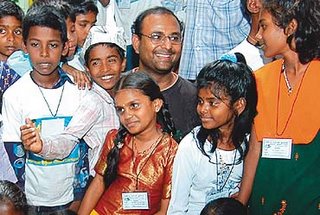Job Description: WHISTLER!!

I read this very interesting article in 'The Telegraph' by Vishnupriya Sengupta about Nagesh Surve who has charmed Bollywood with his whistling for three decades!
Subhanallah,” that is how Lalit of the Jatin-Lalit duo — the music composers of Fanaa — describes this ace whistler. Not without reason. Whistling sets the mood of the song, Subhanallah in Fanaa. It runs as a parallel theme throughout the film, conveying much more than an amalgam of lyrics and musical instruments.
Meet Nagesh Surve, 57, who has been Hindi filmdom’s chief whistler for more than 30 years. So melodious is his whistling that it is often mistaken for the flute. Last year, when the late Pt Bismillah Khan heard him whistling snatches of raga Yaman Kalyan, he assumed that Surve was playing it on the flute. Kishore Kumar’s compliment too rings in his ears: “You whistle just as I sing — effortlessly and flawlessly.”
Music composers of Bollywood don’t hesitate to shower accolades on him. From Pyarelal — of the Laxmikant Pyarelal team — to Pritam , who has used his whistling prowess in the much-awaited Dhoom II, everybody agrees that “he is not just the best but the only whistler in the film industry who has a tremendous sense of mike balancing”.
From Julie to Karz, Hero to Tezaab, Kuch Kuch Hota Hai to Koi Mil Gaya, Satya to Lage Raho Munnabhai, not to forget the bird calls in Paheli and Krrish, Surve has whistled his way unfailingly through tinsel world. His career as the ace whistler in 1400 Bollywood flicks spans three decades, and yet his face expresses nothing but humility.
His modest recording studio, which doubles as his residence, is tucked in one of the flats in a housing estate in Goregaon East. The room — with its perforated walls, two huge sound boxes, spools and microphones — exudes an old world charm in keeping with the avuncular image of the man himself.
“The other day my doctor was telling me casually that the Subhanallah ring tone is just incomparable. ‘Kya whistling ki hai,’ he had exclaimed. He didn’t know that I was the one who had whistled the tune. I didn’t tell him, or else he would have hiked his fee,” chuckles the unassuming Surve, interspersing his words with some impromptu whistling.
Most people in the locality know him as music director Rishiraj, who has done the background score for several Hindi and Marathi films. In fact, last year he won a state award for his score in the Marathi film, Mi Tujhi Tujhich Re. “In the Seventies, there was another person in the film industry by the name Nagesh. So I decided to rechristen myself,” he explains.
Surve has a firm grounding in both eastern and western classical music — he is both a sitarist and a violinist. He spent his childhood in Dadar in a neighbourhood which was more of a musical conglomerate comprising the likes of Laxmikant Pyarelal, Vasant Desai and Jaikishan. “I was friends with Pyarelal. We went to the same Bombay municipality school. It was from his father, Ramprasad Sharma, that I learnt to play the violin. Of all the musical instruments, I think playing the violin is the toughest,” he says.
The exposure to both eastern and western classical music helped hone his skill as a musician while his visits to a nearby recording studio where he would attend sessions for hours on end drew him gradually into the vortex of Hindi film music.
Initially, he played the sitar and then the violin in the orchestra. Whistling happened by chance. “Kishore Sharma, who was then assistant music director to Usha Khanna, heard me whistling once and said that he had never heard such melodious notes before. He said that they would use my whistling in the film Pyasi.” Later, Lakshmikant Pyarelal gave him a break in Subhash Ghai’s Hero.
That marked the turning point of Surve’s career. Whistling took centrestage though the whistler himself preferred to remain in the wings. “Anyone can whistle,” says Lalit. “But Surve whistles by just looking at the notations. He knows how to improvise, and his sense of cadence and technique is excellent.” Pritam, Dhoom II’s music director, agrees. The whistling in Dhoom II is restricted to a song which virtually has no musical instruments. “It has the sound of objects of daily use like, say, the trash can. So whistling is an integral part of that number.”
Surve has set himself another goal now. He plans to cut an album of ragas. “Many companies have asked me to whistle tunes of old Hindi film numbers. But that doesn’t excite me. What I would like to do is cut an album comprising Indian ragas.” His face glows as he puckers his lips and gives a quick demonstration of how he would whistle an alap or a jhala.
That denotes a long journey for whistling which hasn’t quite been able to rid itself of its derogatory association with eve teasing. “That is why it’s not taken seriously,” Surve laments. True, there have been singers in the West — like Roger Whittaker and John Lennon — who have been known to whistle and sing with equal dexterity. Back home, the late R.D. Burman made it an indispensable component of filmi music.
Whistling as a source of melody, will always have to come from within. It can never be reproduced digitally as the keyboard — which dominates today’s world of music — can never capture the subtle nuances of the sound of whistling.
But Surve is hopeful about the future of his craft. So he has trained his younger daughter Rupali who has whistled alongside him in films like Hum Dil De Chuke Sanam and Dhoom II. And with Eves like Rupali taking to whistling, maybe they will succeed in teasing out the derogatory connotation of whistling and help it gain due recognition.

